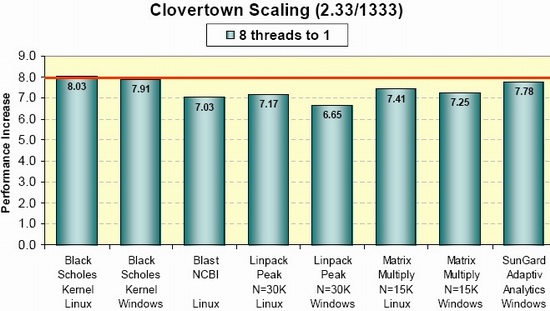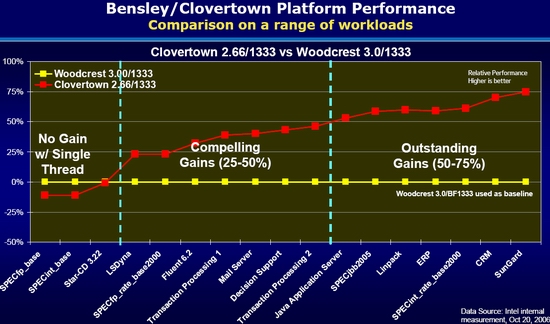Quad Core Intel Xeon 53xx Clovertown
by Johan De Gelas on December 27, 2006 5:00 AM EST- Posted in
- IT Computing
Analysis
When it comes to power consumption numbers, we could only compare the quad core Xeon with the dual core one. Our Opteron platform was too different to make such comparisons meaningful. In Specjbb2005, the Clovertown machine consumed about 20 to 40 Watt more, which is about 8 to 15 percent. If you want to compare the Xeon with the Opteron platform, check out Jason and Ross' testing here.
Let us summarize what we have learned so far. Thanks to the very competitive price, the new quad core Xeon is in many applications a winner when it comes to price/performance: a dual socket server is a lot cheaper than a quad socket model and a 2.33GHz quad core Xeon costs the same as a dual core Xeon 5160. Despite the very aggressive price setting and the excellent per socket performance, the newest Xeon is not unbeatable, a result of mediocre scaling.
To put everything in perspective, you can never give enough benchmarking numbers. Let us see what Intel's own benchmarking tells us. First Intel shows off some benchmarks which really demonstrate fantastic scaling moving from one core to eight.

Eight benchmarks which scale excellent makes for a very nice chart, but in reality we are only looking at three different benchmarks. Blast, Linpack and matrix multiplies can all be categorized as matrix multiply benchmarks. Scholes and Sungard ACR use different algorithms, but both are products of Sungard and both are used in the financial world. They have a high value to financial analysts who use these tools, and complete our analysis. We found that per socket, the quad core Xeon offers about twice the performance of the dual Opteron per socket, and about 10% per core (Octal core 2.33GHz Xeon versus 2.4GHz octal Opteron). So yes, there are applications out there where a "Clovertown" Xeon is a huge step forward. The question is how common are these situations? Intel seems to have anticipated this question and the performance group of Portland presented a very interesting slide.

Notice that Intel uses a 120W TDP 2.66GHz quad core Xeon and not the 2.33GHz we tested. Considering that everybody - including Intel - agrees that we should go for maximum performance/watt, we would chose the 2.33GHz instead, as it has the same TDP as the Xeon 5160 3GHz which is used as baseline. This means that we have to subtract about 13% of the performance figures if we want to keep the TDP the same, and in that case some of the "compelling gains" are no longer really tangible. So we can conclude that CRM, Financial analysis, ERP and Java applications are the best applications for our Clovertown Xeon. For rendering, transaction processing, and especially structural simulation (LS Dyna) and flow modeling (fluent) the picture is a lot less clear.
When it comes to power consumption numbers, we could only compare the quad core Xeon with the dual core one. Our Opteron platform was too different to make such comparisons meaningful. In Specjbb2005, the Clovertown machine consumed about 20 to 40 Watt more, which is about 8 to 15 percent. If you want to compare the Xeon with the Opteron platform, check out Jason and Ross' testing here.
Let us summarize what we have learned so far. Thanks to the very competitive price, the new quad core Xeon is in many applications a winner when it comes to price/performance: a dual socket server is a lot cheaper than a quad socket model and a 2.33GHz quad core Xeon costs the same as a dual core Xeon 5160. Despite the very aggressive price setting and the excellent per socket performance, the newest Xeon is not unbeatable, a result of mediocre scaling.
To put everything in perspective, you can never give enough benchmarking numbers. Let us see what Intel's own benchmarking tells us. First Intel shows off some benchmarks which really demonstrate fantastic scaling moving from one core to eight.

Eight benchmarks which scale excellent makes for a very nice chart, but in reality we are only looking at three different benchmarks. Blast, Linpack and matrix multiplies can all be categorized as matrix multiply benchmarks. Scholes and Sungard ACR use different algorithms, but both are products of Sungard and both are used in the financial world. They have a high value to financial analysts who use these tools, and complete our analysis. We found that per socket, the quad core Xeon offers about twice the performance of the dual Opteron per socket, and about 10% per core (Octal core 2.33GHz Xeon versus 2.4GHz octal Opteron). So yes, there are applications out there where a "Clovertown" Xeon is a huge step forward. The question is how common are these situations? Intel seems to have anticipated this question and the performance group of Portland presented a very interesting slide.

Notice that Intel uses a 120W TDP 2.66GHz quad core Xeon and not the 2.33GHz we tested. Considering that everybody - including Intel - agrees that we should go for maximum performance/watt, we would chose the 2.33GHz instead, as it has the same TDP as the Xeon 5160 3GHz which is used as baseline. This means that we have to subtract about 13% of the performance figures if we want to keep the TDP the same, and in that case some of the "compelling gains" are no longer really tangible. So we can conclude that CRM, Financial analysis, ERP and Java applications are the best applications for our Clovertown Xeon. For rendering, transaction processing, and especially structural simulation (LS Dyna) and flow modeling (fluent) the picture is a lot less clear.










15 Comments
View All Comments
zsdersw - Friday, December 29, 2006 - link
Smithfield/Paxville is a MCM chip (two pieces of silicon in one package), as well.
Khato - Wednesday, December 27, 2006 - link
Agreed on it being quite the good review, save for the lack of power consumption numbers/analysis. Form factor and power consumption can be just as important as the performance when the application can be spread across multiple machines, now can't it? At the very least, it would be nice to link to the power consumption numbers for the opteron platform in the first review it showed up in (which puts the dual clovertown at 365W load, while the quad 880 is supposedly 657W load.)rowcroft - Wednesday, December 27, 2006 - link
Loved the article, great job.I'm in the process of purchasing two dual quad core servers for VMWare use. Looking at the cost to performance analysis, it would be worth mentioning that many of the high end applications are licensed on a per socket basis. This alone is saving us $20,000 on our VMWare license and making it a compelling solution.
I would love to see more of this type of article as well- very interesting and not something you can easily find elsewhere on the net. (Tom's hardware reviewed the chip running XP Pro!)
duploxxx - Friday, December 29, 2006 - link
If you think that reading this review will help you to decide what to buy as VMWARE base you are going the wrong way! Yes these small tests are in favor for the new MCW architecture as we saw before and since haevy workload seems hard to test for some sites like anand! keep in mind that VMWARE is heavy workload, you combine the cpu and ram to whatever you want, guess what the fsb can't be combined like you wish!thinking that a 2x quad will outperform the 4p opteron is a big laugh! the fsb will kill youre whole ESX instantly from 4+ os on your system with normal load.
the money you save is indeed for sure, the power you loose is an other thing!
friendly info from a certified esx 3.0 beta tester :)
Viditor - Wednesday, December 27, 2006 - link
Probably one of your most thorough and well-rounded articles Johan...many thanks!It was nice to see you working with large (16GB) memory.
If you do get a Socket F system, will you be updating the article?